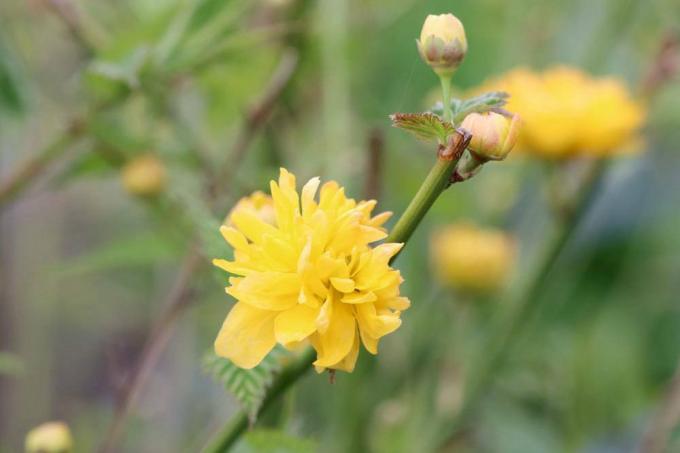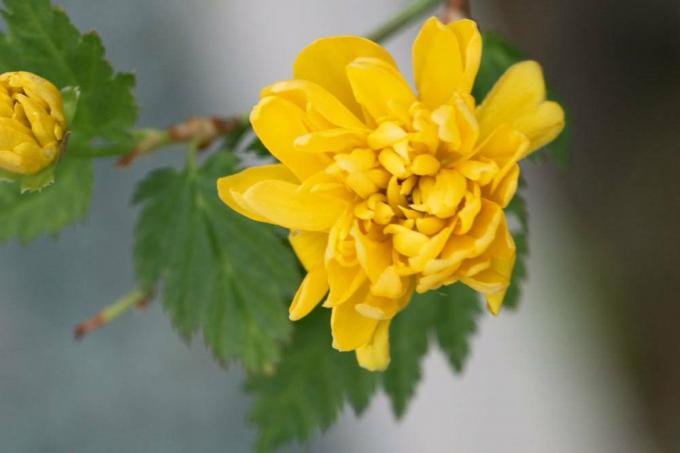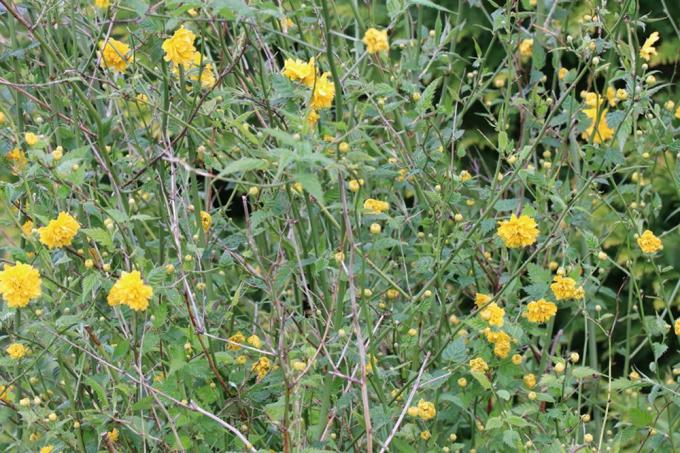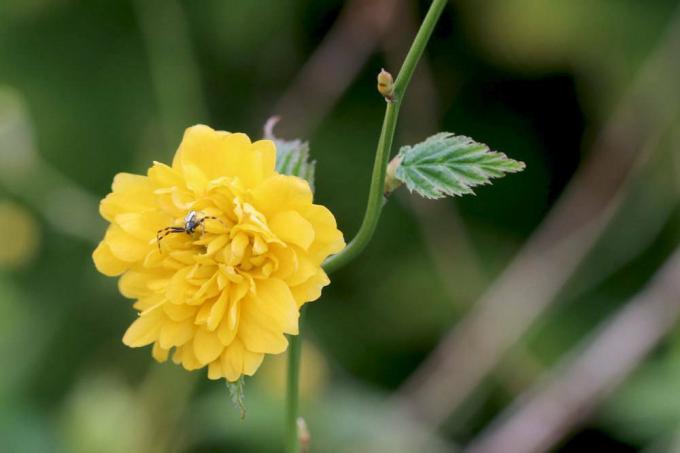
table of contents
- Location
- care
- plants
- to water
- Fertilize
- Cut
- wintering
- Multiply
- Diseases
Profile and care information open +conclude -
- Flower color
- yellow
- Location
- Partial shade, sunny
- Heyday
- April, May, June, August, September
- Growth habit
- upright, expansive
- Soil type
- sandy
- Soil moisture
- moderately moist, fresh
- PH value
- weakly acidic
- Limescale tolerance
- k. A.
- humus
- k. A.
- Poisonous
- Yes
- Plant families
- Rose family, Rosaceae
- Plant species
- Ornamental shrubs, shrubs, flowering shrubs
- Garden style
- Cottage garden, flower garden, country house garden
With its densely filled, bright yellow flowers, it conjures up Ranunculus Pleniflora bring spring to your garden. The Asian ornamental wood comes along with undemanding frugality and reliable winter hardiness. Of course, a Kerrie makes no secret of her urge to spread by cheekily sending her offshoots into the bed. These care instructions and pictures give you the horticultural tools to transform a Kerria japonica into a decorative eye-catcher on both sides of the garden fence.
Location
The closer the general conditions at the site to the conditions in the habitat, the lower the maintenance effort. Under the influence of the following light, temperature and soil conditions, a Kerria japonica Pleniflora shows its most beautiful side and is immune to diseases and pests.
- sunny to partially shaded location without blazing sun during midday
- warm and bathed in air, without summer accumulation of heat
- nutrient-rich, humus-rich and loosely drained soil
- fresh-moist to moderately dry
- neutral to slightly acidic pH from 5.5 to 7.0

care
Its decorative silhouette and lavish abundance of flowers make the double golden rose a popular container plant. When choosing the substrate, please do not use potting soil from the discounter, but buy high-quality, structurally stable potting soil with a low percentage of peat. The addition of lava granules, perlite and a handful of sand gives the soil the desired permeability.
plants
The Kerria japonica Pleniflora (double ranunculus) inspires both as a solitary plant and as a small hedge. Together with trees and other flowering bushes, the Asian piece of jewelery makes an eye-catching contribution to the overall appearance of the garden. When planting, it is important to note that the shallow root tends to overgrow, as the numerous runners strive in all directions. Forward-looking gardeners therefore keep growth in check with a root barrier.
How to Plant the Kerrie with Expertise:
- the best time to plant is in spring, when the soil has thawed
- Soak the root ball with water until no more air bubbles rise
- meanwhile dig spacious planting pits with a depth of 50 cm
- Planting distance for a cut hedge is 50 cm, otherwise 100 cm
- line the pit walls with a root barrier
- Enrich the excavation with leaf compost and horn shavings
- insert the golden rose, press the soil down and pour soft water over it

You can buy a root barrier as a rot-proof geotextile from specialist retailers. A thickness of at least 1 mm is advisable so that the material can withstand the pressure. Line the pit about 50 cm deep, with the two ends overlapping by 10 cm.
So that the shallow roots and runners do not seek an escape route over the edge of the root barrier, it should stand as a pouring edge 5-10 cm above the soil surface. Alternatively, you can use a mason's tub to block the roots by knocking out the soil, inserting it into the planting hole and filling it with substrate.
to water
As a shallow root, a double ranunculus does not have deep-reaching root strands that draw water from the depths of the ground in summer drought. The ornamental wood is therefore dependent on regular watering when there is no rain. Therefore, use a thumb test to check whether the soil is dry.
Let the water run from the spout onto the root disc until no more moisture is absorbed. Please avoid watering the shrub to prevent unsightly spots from forming on the leaves. In addition, moist foliage offers various pathogens an ideal target for attack.
For watering please use mainly soft rainwater or decalcified tap water. Normal, hard water causes an excess of lime in the soil, as a result of which leaf chlorosis and other diseases spread.
Fertilize
The nutrient supply of a Kerrie is at a low level. The more nutritious the soil, the less fertilizer is required. The golden rose reacts to the concentrated nitrogen load of mineral fertilizers with an increased growth of the leaves and neglects the flowers.

- in March / April with leaf compost and Horn shavings fertilize
- Spread the organic material 3 cm thick, rake in on the surface and pour over
- In September, shower the root slice with potassium-rich comfrey manure
- alternatively, administer a low concentration of potassium fertilizer
In the limited substrate volume of a bucket, the nutrient stocks are used up more quickly. So fertilize every 4 weeks from April to August with a liquid fertilizer for flowering trees in half the concentration. By the end of September at the latest, stop the supply of nutrients in both the bed and the tub so that the shrub can mature.
Cut
If a double ranunculus bush (Kerria japonica) has established itself well at the site, it will begin to shed from the inside after a few years. From the fourth or fifth year of standing in the bed, the maintenance program is therefore supplemented by an annual cut. As the splendid flowers unfold on the annual and biennial twigs, older branches are thinned out. You can tell the difference well by the fact that young twigs have green bark, while worn shoots have brown-gray bark.
This cut has proven itself excellently for the pleniflora in practice:
- sharpen the scissors or saw and carefully disinfect with alcohol
- at the end of the main flowering period in May / June, thin out the old, gray-brown wood
- Shorten dead and dry twigs to 5 to 10 cm
- Cut back young shoots that are too long by a maximum of a third
- make these cuts a short distance above a bud or leaf knot
- Cut off runners by the nose with a spade or pull them out of the ground
Since the seeds of a Kerrie are poisonous, the withered flowers in the family garden should be cleaned off in good time. To do this, place the scissors between a withered flower and the next healthy pair of leaves. In the case of the double flowers of a pleniflora, this measure is only required during the autumn re-flowering.
Only the simple flowers of the second bloom produce the fruits, the seeds of which are poisonous for humans and animals. However, the contained hydrocyanic acid glycosides are contained in the seeds in a very low concentration and only develop their toxic effect when consumed in larger quantities.

wintering
The wild form of Kerria japonica found its way to Europe from the rough mountainous regions of East Asia. The winter hardiness acquired in the habitat could be preserved in the double blooming pleniflora. The following precautions are only advisable in the year of planting and in the tub to guide the ornamental wood safely through the cold season.
- Before the first winter, cover the root disc with leaves and brushwood
- place a bucket on wood and wrap it with jute ribbons or fleece
- cover the substrate with wood wool, autumn leaves or sawdust
A well-rooted double ranunculus can dispense with special winter protection measures in the bed. Only under the influence of clear frost does the ornamental wood require a little gardening attention. If winter comes with freezing frost and bright sunshine, without a blanket of snow, the golden rose is threatened by drought stress. Therefore, pour soft water on mild days.
Multiply
Basically, it is completely sufficient if you buy a single double ranunculus (Kerria japonica Pleniflora), because propagation is easy. Primarily, the following vegetative methods are recommended for the home garden. The resulting young plants show exactly the attributes of their mother plant. In contrast, the generative propagation by sowing proves not only to be time-consuming, but also to be tricky, since the seeds are poisonous.
Runners
Every offshoot of a Kerrie has the potential to transform itself into a lavishly blooming golden rose. To do this, dig up a strong root strand in the spring and separate it from the mother plant with a sharp cut. At the new location, dig a small pit in order to plant the 10-20 cm long piece of root so that the previous depth is maintained.
Cuttings
If a double ranunculus is in full bloom, this is the best time for propagation with head cuttings. To do this, choose green, semi-lignified and non-flowering branches. Cut these off over a length of 10 to 15 cm, using the scissors below a leaf knot. A leaf knot can be seen as a small bump under the bark.
How to proceed:
- defoliate each cutting in the lower part
- put in a glass with filtered rainwater
- Replace the water regularly in the partially shaded, warm location

If roots 3-5 cm long have formed on the cuttings, plant them in a propagation bed in a partially shaded, protected location. Water the young golden florets regularly. For the winter, cover the young plants with breathable fleece or a thick layer of leaves and brushwood. In the next spring, put the well-rooted ranunculus bushes with a root barrier in their final place in the bed.
Diseases
The Kerria japonica Plenifolia has understood well how to develop robust resistance to widespread diseases. However, the blooming herald of spring is not completely immune to pathogens. The most common infections in golden rose are explained in more detail below with tips for effective control.
mildew
In warm, humid weather with temperatures above 20 degrees and more than 60 percent humidity, floury-gray spots form on the leaves. These continue to spread and turn brown, whereupon the foliage dies. The spores of powdery mildew, one of the most common diseases in the ornamental and kitchen garden, are responsible for the mishap.
How to take action against the infection:
- cut off all the leaves with stains and dispose of them with household waste
- spray the affected plant with a mix of 875 ml of water and 125 ml of fresh milk
- continue the treatment every 2-3 days
At an advanced stage, you can still achieve good control results with fungicides based on neem oil, without having to resort to chemical preparations. In this case, ecologically responsible home gardeners buy the powdery mildew combination pack, which is made up of neem oil, powdery mildew salt and liverwort.
Star soot
If gray-black spots spread out like rays on the leaves of a Kerria japonica, the pathogens of the fungal infection blackened soot have struck. This disease not only targets roses, it also affects all rose plants, including the Kerrie. Unfortunately, there is currently a lack of effective organic or chemical control agents.
By consistently cutting off each infected leaf, you will keep the spread under control. Spraying fungicides containing azoxystrobin or myclobutanil when budding in spring can at least contain the infection.

In contrast, leaf chlorosis is not caused by viruses, spores or bacteria. If a double ranunculus is poured exclusively with hard tap water, the lime content accumulates in the substrate. As a result, important nutrients are set which are no longer transported into the leaves via the roots. As a visible sign, yellow spots form on the foliage, with the green leaf veins clearly showing through. By switching the water supply to collected rainwater or decalcified tap water, the damage can be repaired.



